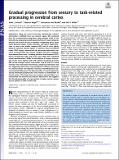| dc.contributor.author | von Nicolai, Constantin | |
| dc.contributor.author | Brincat, Scott Louis | |
| dc.contributor.author | Siegel, Markus | |
| dc.contributor.author | Miller, Earl K | |
| dc.date.accessioned | 2019-03-04T21:33:42Z | |
| dc.date.available | 2019-03-04T21:33:42Z | |
| dc.date.issued | 2018-07 | |
| dc.date.submitted | 2017-09 | |
| dc.identifier.issn | 0027-8424 | |
| dc.identifier.issn | 1091-6490 | |
| dc.identifier.uri | http://hdl.handle.net/1721.1/120717 | |
| dc.description.abstract | Somewhere along the cortical hierarchy, behaviorally relevant information is distilled from raw sensory inputs. We examined how this transformation progresses along multiple levels of the hierarchy by comparing neural representations in visual, temporal, parietal, and frontal cortices in monkeys categorizing across three visual domains (shape, motion direction, and color). Representations in visual areas middle temporal (MT) and V4 were tightly linked to external sensory inputs. In contrast, lateral prefrontal cortex (PFC) largely represented the abstracted behavioral relevance of stimuli (task rule, motion category, and color category). Intermediate-level areas, including posterior inferotemporal (PIT), lateral intraparietal (LIP), and frontal eye fields (FEF), exhibited mixed representations. While the distribution of sensory information across areas aligned well with classical functional divisions (MT carried stronger motion information, and V4 and PIT carried stronger color and shape information), categorical abstraction did not, suggesting these areas may participate in different networks for stimulus-driven and cognitive functions. Paralleling these representational differences, the dimensionality of neural population activity decreased progressively from sensory to intermediate to frontal cortex. This shows how raw sensory representations are transformed into behaviorally relevant abstractions and suggests that the dimensionality of neural activity in higher cortical regions may be specific to their current task. Keywords: categorization; cognition; prefrontal cortex; posterior parietal cortex; dimensionality | en_US |
| dc.description.sponsorship | National Institute of Mental Health (U.S.) (Grant 5R37MH087027) | en_US |
| dc.publisher | National Academy of Sciences (U.S.) | en_US |
| dc.relation.isversionof | http://dx.doi.org/10.1073/pnas.1717075115 | en_US |
| dc.rights | Article is made available in accordance with the publisher's policy and may be subject to US copyright law. Please refer to the publisher's site for terms of use. | en_US |
| dc.source | PNAS | en_US |
| dc.title | Gradual progression from sensory to task-related processing in cerebral cortex | en_US |
| dc.type | Article | en_US |
| dc.identifier.citation | Brincat, Scott L. et al. “Gradual Progression from Sensory to Task-Related Processing in Cerebral Cortex.” Proceedings of the National Academy of Sciences 115, 30 (July 2018): E7202–E7211 © 2018 National Academy of Sciences | en_US |
| dc.contributor.department | Massachusetts Institute of Technology. Department of Brain and Cognitive Sciences | en_US |
| dc.contributor.department | Picower Institute for Learning and Memory | en_US |
| dc.contributor.mitauthor | Brincat, Scott Louis | |
| dc.contributor.mitauthor | Siegel, Markus | |
| dc.contributor.mitauthor | Miller, Earl K | |
| dc.relation.journal | Proceedings of the National Academy of Sciences | en_US |
| dc.eprint.version | Final published version | en_US |
| dc.type.uri | http://purl.org/eprint/type/JournalArticle | en_US |
| eprint.status | http://purl.org/eprint/status/PeerReviewed | en_US |
| dc.date.updated | 2019-02-08T18:31:02Z | |
| dspace.orderedauthors | Brincat, Scott L.; Siegel, Markus; von Nicolai, Constantin; Miller, Earl K. | en_US |
| dspace.embargo.terms | N | en_US |
| mit.license | PUBLISHER_POLICY | en_US |

